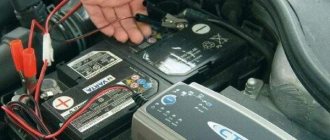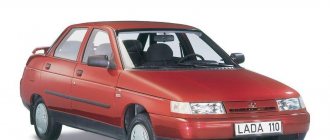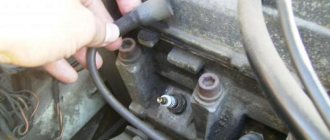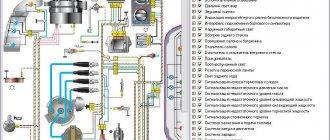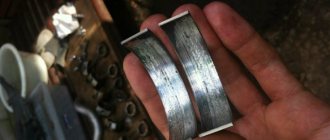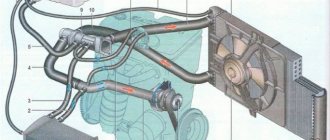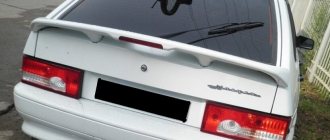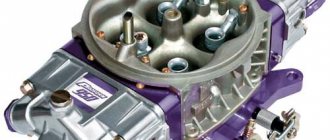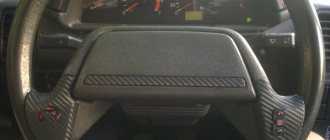Lack of spark on the spark plugs is one of two basic faults most often found on cars (the second is no fuel supply to the engine). Loss of spark or weak spark from the spark plugs indicates problems in the ignition system. Either in a high voltage circuit or a low voltage circuit. In this case, the car engine will not start at all (both cold and hot), or will start and stall (if there is a spark, but weak). Let's consider the main reasons for the loss of spark on carburetor engines of VAZ 2105, 2107, 2108, 2109, 21099 cars with contact and non-contact ignition systems.
Then we remove the central high-voltage wire, insert a working spark plug into its tip and place it on the engine (so that there is contact with ground). While the assistant turns the engine with the starter, you need to visually verify the absence or presence of a spark at the spark plug. A spark has appeared - the spark plugs themselves, the high-voltage wires or the ignition distributor in the distributor are faulty. There was still no spark - problems with the switch, Hall sensor, ignition coil.
Lost spark, reasons for contactless ignition system
- The ignition coil has failed.
Checking the ignition coil. The ignition coil is usually checked for winding resistance and insulation resistance using a tester. For oil-filled coils (27.3705) and dry coils (3122.3707), the resistance is slightly different. Read more: “Checking the ignition coil.” In the absence of a special device for testing, we use the method of replacing our coil with another one that is known to be good.
checking the primary winding of the ignition coil
- The switch is faulty.
Checked with an oscilloscope. Since not everyone has it, we use the replacement method - instead of our switch we install a known good one. You can very roughly estimate the performance of the switch based on the voltmeter readings after turning on the ignition (see “Checking the switch”).
- Hall sensor is faulty.
It is checked with a voltmeter according to a special connection diagram (see “Checking the Hall sensor”). If there is no voltmeter, we use the replacement method.
Hall sensor, check
- Open circuit in low voltage circuit.
Using the diagram, we look through the wires included in the ignition system, and if necessary, “ring” to detect a “break.” See "Contactless Ignition System Diagram".
In the contact ignition system, the list of malfunctions leading to the disappearance of the spark is as follows:
- The mechanical breaker in the distributor is faulty.
Its contacts have oxidized, collapsed or burned. There is no gap between the breaker contacts.
breaker contacts
- The ignition coil is faulty.
- "Open" in the low voltage circuit.
Notes and additions
— To quickly find the reason for the disappearance of the spark on the spark plugs, you need to know the principle of operation of both contact and non-contact ignition systems (for more details, see “The principle of operation of the ignition system”). The purpose of the ignition system is to generate high voltage current at the right moment and supply it to the spark plugs. This is accomplished by interrupting the low voltage current in the primary winding circuit of the ignition coil. In a contactless system, the switch interrupts the current based on a signal from the Hall sensor; in a contact system, a mechanical breaker with contacts is driven by a tetrahedron on the distributor shaft.
More articles on the ignition system of VAZ cars
Post by USA » 03 Dec 2011, 19:48
The spark went into the ground, dig deeper (c)
Why does the VAZ-2107 twitch - let’s understand the operation of the “distributor”
Well, if the engine of your VAZ-2107 suddenly stalls and does not start, we will find the reason and eliminate it quickly. Everyone knows that this happens if the “spark” disappears or there is no gasoline supplied at all. It’s much worse when the car seems to be moving, but the nerves are fraying - uneven idling, jerking and twitching when driving. Finding the root of the problem can take a lot of time and take a lot of money out of your pocket. And more often than not, these searches ultimately lead to a distributor. This material will help you correctly replace it with a working one, select a suitable replacement, and understand the device and operation.
Before delving into the “electrics”, it must be said that the reason for the “jerking” of the VAZ-2107 and other “classic” VAZ models may be an unsuccessful combination of the clutch driven disc damper and the elastic coupling of the driveshaft. Spare parts are supplied with parts whose characteristics may differ greatly from the factory ones, therefore, if the “jerking” intensifies after replacing the clutch or “soft connection”, you need to look for the cause there. Try installing a unit from another manufacturer - its characteristics will be different, the resonance in the transmission will disappear and the “jerking” will stop.
No fuel supply
In addition to problems in the ignition system, the VAZ 2107 engine may experience difficulty starting if there is a problem with the fuel system. Since they are different for injection and carburetor internal combustion engines, the problem is solved differently.
On the injector
If an engine equipped with a fuel injection system does not start due to a lack of gasoline supply (there is enough gasoline in the tank), then the problem lies in the fuel pump.
When the driver turns on the car's ignition, he should hear the sound of the pump. At this moment, the pressure necessary for the operation of the fuel injectors is created in the line. If this sound is not heard, then the engine will not start or will constantly stall.
On the carburetor
If little or no gasoline flows into the carburetor, then checking the fuel pump in this case is a little more difficult. The procedure is performed in the following sequence.
- The fuel hose is disconnected from the carburetor and lowered into a separate clean container.
- Crank the starter for 15 seconds. During this time, at least 250 ml must be pumped into the container. fuel.
- At this moment, gasoline should pour out under slight pressure. If the stream is weak or does not exist at all, you can buy a fuel pump repair kit and replace the gaskets and membrane. Otherwise, the part is replaced.
As you can see, there are plenty of reasons for problematic engine starting on the VAZ 2107. Most of them can be diagnosed independently without the expense of troubleshooting at a service station. It is important to understand the operating principle of the ignition and fuel supply system. They work in a logical sequence and many faults do not require special electrical or mechanical knowledge to resolve.
What signs indicate a malfunction of the VAZ car distributor?
1. The engine does not start: - there is no gap or too large a gap between the breaker contacts; -burnt and dirty contacts; - the capacitor has failed; - the noise suppression resistance of the “slider” has burned out; - the distributor cover is “broken”; - the low voltage wire is broken or its terminals are oxidized; -Hall sensor burnt out (non-contact ignition). 2. The engine “shakes” at idle: - the gap between the contacts is not normal; - ignition too early. 3. The engine “jerks” at high speeds: - the gap between the breaker contacts is too large; - the spring of the movable contact of the breaker has weakened; - the springs of the centrifugal regulator have weakened. 4. “Jerking”, interruptions in all engine modes: -damage to high voltage wires, oxidized or loose in the sockets; -dirty, oily, burnt breaker contacts; - the corner of the moving contact in the distributor cover is worn out or broken; -cracks and burnouts of the “runner” and the distributor cover; - the capacitor is “half broken” and needs to be replaced; - the bushings are worn out and the distributor shaft is “playing”; - the contactless ignition system switch is faulty. 5. The car accelerates slowly, consumes a lot of fuel: -the ignition timing is incorrectly set. Note! Signs of a malfunction of the VAZ-2107 distributor are very easily confused with manifestations of malfunctions in the power system . Therefore, never start disassembling the distributor and carburetor with the fuel pump at the same time!
Causes of sparking problems
Communities Lada Priora Lada Priora Club Blog what affects the clutch release limit switch
If there is no spark on the injector, and not, for example, on a carburetor or gear motor, you will have to try to identify the reasons for its loss. This is due to the fact that there are slightly more factors influencing spark formation in injection systems and they look more multifaceted. If we summarize the general list of possible causes of the problem, then it is worth highlighting the following most common ones:
- The spark plug or spark plugs are flooded with fuel - there is either no spark or very weak, the spark plugs themselves are wet;
- The spark plug or spark plugs are faulty - there is no spark at all, deposits on the contacts are usually black or white;
- The crankshaft sensor, ignition module, ignition coil, switch or distributor is faulty - there is no spark at all, the engine shows no signs of “life”, the injector does not work correctly;
- High-voltage wires have broken through or there has been a loss of contacts - one or two spark plugs do not work, the rest are fully operational;
- The injector electronics (ECU or wires) are faulty - the unit does not work correctly, there is no spark at all spark plugs;
- The injector nozzles are clogged - there is no spark at the spark plugs of specific cylinders, the injector is not working correctly.
Please note that for a complete and most accurate diagnosis, it is necessary to carry out several procedures at once:
- Naturally, check for a spark;
- Assess for the presence of the symptoms described above;
- Check for relevant errors on the dashboard or on-board computer screen;
- Check the potentially faulty unit (disassembly, cleaning, diagnostics with a multimeter, etc.).
Distributor function in the ignition system of a carburetor car
The full name of this device “ignition switch-distributor” reveals part of its “responsibilities” - at a strictly defined time to break the low-voltage circuit of the ignition coil and distribute the resulting high-voltage energy, in a given order (1-3-4-2), among the cylinders . It is also “responsible” for changing the ignition timing depending on the speed of the engine crankshaft (crankshaft) using a centrifugal regulator and “correcting” this angle depending on the load on the engine using a vacuum corrector.
Let's sum it up
Spark plugs play a vital role in the performance of a vehicle. If at least one spark plug fails and does not produce a spark, accordingly, one of the cylinders will not work, the car will have increased fuel consumption and will be less dynamic. Finding the reason for the disappearance of the spark is a very difficult task, since several units may be “to blame” for this. However, for normal functioning this is simply necessary.
Good day everyone) This is the situation: after a short circuit (I removed the voltage regulator because it burned out and the wire touched the body), the spark on the VAZ 2106 disappeared. The ignition is electronic. The ignition coil is working, I checked it on another car. No current flows to the coil. I checked the fuses. What could be the reasons? Maybe the switch, since the red-blue wire that goes from the switch to the coil has melted? The photo shows a melted wire, replaced it.
Which distributor is suitable for the VAZ-2107
On all carburetor rear-wheel drive VAZ cars, the device has almost identical components and a similar operating principle. Distributors for engines with a volume of 1200-1300 cc differ in that: - the drive rod is 7 mm shorter; — no vacuum ignition timing regulator; — the settings of the weights and springs of the centrifugal regulator are different. For engines with a volume of 1500-1600 cc, all distributors are suitable in terms of mounting dimensions and characteristics. Only “Nivovskie” ones differ. They are tuned for stable traction at low speeds and the VAZ-2107 with such a distributor will accelerate slowly. The brands of “Nivovsky” distributors are: 3810.3706, 038.3706-10. And distributors of brands 0.3706 (contact) and 38.3706 (non-contact) are suitable for the “Seven” and other classic cars.
Why won't the walk-behind tractor start?
Repair of a walk-behind tractor will be successful if you correctly diagnose the walk-behind tractor.
The reasons for unit failure are very different:
- The hole in the gas tank is clogged;
- The fuel supply channels are clogged with debris;
- The air filter blocks the entry of clogged air;
- Carburetor failure.
Gasoline and diesel walk-behind tractors must be carefully prepared for seasonal work.
It is important to make sure that all structural elements are in place and securely fastened
Installed Subaru engines or engines of other brands may not start after a long period of inactivity, especially in winter. Incorrect storage conditions for equipment also have a negative impact.
The following malfunctions may occur:
- The contacts in the electrical wiring have oxidized;
- Water has entered the oil or fuel;
- The integrity of the wire insulation has been compromised;
- Debris has accumulated in the carburetor jets.
Before starting the walk-behind tractor, you need to look at all the connections in the units of the device, check the integrity and connections of the throttle, reverse and clutch cables. If clamps or kinked cables are found, this must be corrected in order to start the unit.
It is necessary to check the amount of oil in the crankcase. Lack of lubrication can negatively affect the piston group. A diesel or gasoline walk-behind tractor may not start if there is not enough oil. Some models have low-level protection installed; if it is not there, you need to constantly monitor the volume of lubricating fluid.
It is important to take into account the quality of the gasoline being poured. The walk-behind tractor must be refilled with the brand recommended by the manufacturer, then the unit will work without interruption
Two-stroke engines operate on separately prepared fuel: gasoline and oil. It is important to maintain a strict ratio of substances.
The main components of the distributor and a description of its operation
VAZ classic distributor device
Device
The distributor is assembled in a housing. Inside it, a contact group is mounted on a bearing: moving and fixed contacts or a Hall sensor (for contactless ignition). To correct the advance angle, the vacuum regulator can rotate the contact group at a small angle relative to the housing. The capacitor is attached to the bottom of the case with screws. A drive roller is mounted on bushings in the center of the body. Its bottom has splines with which it engages with the drive gear. In the upper part of the roller there are contact drive cams (for contact ignition) or a steel cup with four slots - a screen (for contactless ignition). At the very top, on a steel platform, two weights and two springs of the centrifugal ignition regulator are installed. A plastic housing with a moving contact and noise suppression resistance of the high voltage distributor (slider) is screwed onto the top with two screws. The entire structure is closed with a lid on two spring latches. The body and cover have a tongue and groove so that they fit together in only one position. The cover contains contact terminals for high voltage wires from the spark plugs and from the ignition coil. The distributor is secured to the engine block using a stud, nut and pressure washer. To adjust the ignition timing, the housing can be rotated relative to the block.
Job
The distributor is connected through the drive to the engine crankshaft and rotates with it. For two full revolutions of the crankshaft, the distributor shaft makes one revolution. This is due to the fact that our engine is four-stroke. When installing the distributor in place, the roller is oriented in strict accordance with the operating order of the engine. This is done so that the contacts open and the spark jumps on the spark plug when the piston of each cylinder, compressing the combustible mixture, does not reach top dead center (TDC) by a few millimeters. This is called ignition advance. When the number of revolutions increases, the distance must be increased, and when it decreases, it must be decreased, which is what the centrifugal regulator does. Its weights, under the influence of centrifugal force, which is greater the higher the engine speed, diverge to the sides and move the cams relative to the roller, making ignition “earlier.” When the engine speed decreases, the springs return the weights to their place and the ignition becomes “later”. This is necessary to increase engine power and efficiency. In addition to the centrifugal one, a vacuum ignition timing regulator is also installed on the distributor. Its function is to fire “earlier” at low throttle opening angles and “later” at sharp throttle opening angles. At idle and at full throttle, the vacuum seal does not work. The regulators are adjusted only at the stands, so there is no need to change the settings yourself.
Lost spark 2107
There is no spark with a short circuit (contactless), there is current at the coil terminals, when the ignition is turned off, a spark jumps
- What is the problem with the ignition of the VAZ 2107? – 5 answers
- What is the reason for the failure of spark plugs (new) in the VAZ 2107 - 4 answers
- Troit when warming up VAZ 2107 - 4 answers
- VAZ 2107 won’t start – 4 answers
- What is the 7th output for in the electronic ignition unit of the VAZ 2107 - 4 answers
If the spark jumps when turning it off, then look at the switch - either power is not coming from the ignition switch, or there is poor contact between the block and the contacts of the switch (just remove and put on the block and the ignition appears).
This means the switch is OK. Hall sensor does not work. Maybe the soldered wires on the inside of the connector have fallen off, or maybe the sensor itself has run out. Or maybe the distributor's shaft was cut off.
And checking the serviceability of the switch is easy. It is enough to remove the ignition harness connector from the distributor and apply negative voltage to the middle terminal briefly and repeatedly. With each short circuit to minus, a spark should jump from the high-voltage terminal of the coil.
“No spark with short circuit (non-contact). " After these words, it is already clear that the coil is faulty.
And that there is current at the coil terminals, it comes there when the ignition is turned on from the lock.
Subscribe
to our channel in
Index.Zen
Even more useful tips in a convenient format
Removal and installation of distributor VAZ-2107, 2104, 2105, 2106
Preparation
Before installing a new VAZ-2107 distributor for a contact ignition system, you need to adjust the gap between the contacts of the breaker. It is more convenient to do this with the device removed from the car. We check the gap with a flat feeler gauge. The value is set from 0.35 to 0.45 mm. In this case, the protrusion of the cam should move the moving contact away from the stationary contact as much as possible. We adjust by slightly loosening the screws, and then tighten them more firmly and check the gap again. Contacts that have worked hard may have a protrusion on one and a depression on the other, which interferes with adjustment. You can get around this problem by grinding off the protrusion with a needle file. It is better not to use sandpaper, because... small particles of abrasive will definitely “eat” into the surface and interfere with the operation of the contacts.
Checking the contact distributor
The need to check the distributor-breaker arises if problems arise with sparking, but during the diagnostics of the ignition system elements the problem could not be identified.
Cover and rotor
First of all, we inspect the cover and rotor of the device. The check consists of the following steps:
- We dismantle the distributor cover and inspect it inside and out. There should be no cracks, chips, or burnt contacts on it. If damage is found, the part must be replaced.
contact Group
The main malfunctions of the ignition distributor contact group are burnt contacts and incorrect clearance between them. In case of burning, the contacts are cleaned with fine sandpaper. If they are severely damaged, it is better to replace them. As for the gap itself, to check it it is necessary to remove the cover of the distributor-breaker and turn the engine crankshaft so that the cam on the distributor shaft opens the contacts as much as possible. We check the gap with a feeler gauge and if it differs from the norm, then we adjust the contacts by unscrewing the corresponding screws and moving the contact plate.
Capacitor
If a capacitor is installed on the distributor of your “six”, then sometimes the part can fail as a result of a breakdown. The malfunction appears as follows:
- problems starting the engine;
- sudden engine stop while driving.
You can check an element in the following ways:
- Control lamp. Disconnect the wiring coming from the coil and the capacitor wire from the distributor according to the figure. We connect a light bulb to the open circuit and turn on the ignition. If the lamp lights up, it means that the part being tested is broken and requires replacement. If not, then it's OK.
Checking the ignition timing of the VAZ-2107 engine
The methods described below make it possible to independently adjust the ignition timing. They are suitable equally well for both contact and non-contact distributors. We adjust the ignition timing at idle speed . We warm up the engine to operating temperature, at idle speed, turning the body relative to the block, “catch” the position in which the speed will be the highest. We fix the distributor in this position. We check the correct setting of the ignition timing “on the fly”. Having looked at a free section of a flat road, we drive out onto it.
We keep the speed at 40 km/h in fourth gear and sharply press the gas pedal. a loud metallic knock should be heard under the hood, disappearing by itself after a few (four to six) seconds. Is everything exactly like this for you? This means the adjustment is complete. If the knocking does not go away for a long time, we stop, loosen the distributor and turn the distributor clockwise a couple of millimeters, making the ignition later. We start the engine again, accelerate, and repeat the test. If there is no knocking at all, then the distributor needs to be turned counterclockwise, setting the ignition “early” and checked again while driving. After doing these steps several times, you get the optimal ignition timing specifically for your VAZ engine. Still have questions? Watch this video
VAZ 21074 engine starting problems
- Registration
- Entrance
- To the beginning of the forum
- Forum Rules
- Old design
- FAQ
- Search
- Users
It disappeared immediately after changing the fine fuel filter, but after 2-3 weeks it came out again.
yeah. This is an interesting feature. That is, you change gasoline. filter and 2-3 weeks starts with half a kick? I have the same story (I haven’t changed any filters yet, I’ll go to a service station in a month), but on the advice of a specialist I do this - 1. turn on the ignition for 5 seconds 2. turn off the ignition (short pause) 3. turn on the ignition for 3 seconds - starter ! It will start, but for the first seconds the engine spins dead, and is about to stall.
thinking out loud - isn't the gasoline dirty? Or is there some nasty stuff left in the tank from filling up with bad gasoline? Thinking further - change the filter - NORMAL engine start for 2-3 weeks - AGAIN the filter is “clogged” - problems with starting. Thoughts about the pump - if the pump did not provide the REQUIRED pressure (2.8-3.2), then it would be difficult or impossible for the engine to start either hot or cold, right? And if the engine starts with half a kick when hot, this means that the pressure in the ramp is normal. Although. I will definitely have to try it on to eliminate this point from suspicion
yeah. This is an interesting feature. That is, you change gasoline. filter and 2-3 weeks starts with half a kick?
1. turn on the ignition for 5 seconds 2. turn off the ignition (short pause) 3. turn on the ignition for 3 seconds - starter! It will start, but for the first seconds the engine spins dead, and is about to stall.
for the first few seconds the engine spins at full speed and is about to stall
thinking out loud - isn't the gasoline dirty? Or is there some nasty stuff left in the tank from filling up with bad gasoline?
Although. I will definitely have to try it on to eliminate this point from suspicion
Source
Fuel supply faults
It is quite easy to find out that the car stalls while driving due to the engine being “choked” with the fuel mixture - during a long drive you will find that the signal of the sensor responsible for this function is constantly on.
Here the problem lies in low-quality fuel, which does not quickly “ignite” from the spark of the candles. It can also be caused by gasoline not meeting the requirements for the octane number specified in the vehicle specifications. If there are problems with fuel, the gas pedal will be pressed all the way, and the car will not begin to gain speed. In addition, the car will periodically stall when the clutch is engaged.
Another symptom indicating problems with fuel is the appearance of problems with the car after refueling. The problem is characterized by a rapid drop in engine power at full speed, as well as when constantly changing gears. The way out of the situation is to completely drain the bad fuel mixture, wash the engine and all the fuel system pipes.
Also, the car will constantly stall if there is an interruption in the supply of the fuel mixture. This may be due to contamination in the following system components:
- Dirt in the fuel filter;
- Problems with injector nozzles;
- Dirty throttle valves;
- Fuel pump power failure.
